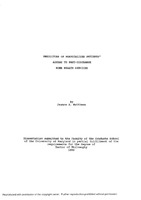Predictors of hospitalized patients' access to post-discharge home health services
View File(s)
Visitor Statistics
Visits vs Downloads
Visitors - World Map
Top Visiting Countries
| Country | Visits |
|---|
Top Visiting Cities
| City | Visits |
|---|
Visits (last 6 months)
Downloads (last 6 months)
Popular Works for Matthews, Jeanne A. by View
| Title | Page Views |
|---|
Popular Works for Matthews, Jeanne A. by Download
| Title | Downloads |
|---|
View Citations
Citations
An ex post facto study was conducted to identify factors associated with diabetic patients' access to home health services following hospital discharge. The Andersen (Aday, Fleming, & Andersen, 1984) model of access served as the conceptual framework for the study which examined the relationship between the predisposing, enabling, and need characteristics of the sample, and the realized access indicators of referral to, and acceptance for post-discharge home health services. A sample of 300 hospitalized patients was identified at three study sites. One-half of the sample had been referred for home health services and one-half had not been referred for post-discharge home health services. Data regarding acceptance for services were collected on 136 patients. Discriminant analysis was conducted to identify the set of predictors of referral and subsequent acceptance for home health services. A discriminant function, strongly related to dependency, was found to maximize the differences between groups referred and not referred, and accounted for 33.5% of the variance between groups (p $<$.0001). Length of stay, number of secondary diagnoses, age, and marital status showed moderate association with the function. Stepwise discriminant analysis identified a six variable function, in which dependency was the primary predictor, that significantly (p $<$.0001) discriminated between the groups. No differences were found between the groups accepted and not accepted for home health services following referral. Nine research hypotheses were tested for significance using chi square and correlations. Patients more likely to be referred for home health service were older, female, lived alone or with friends or family other than a spouse, were covered by Medicare or Medicaid, had a longer hospital stay, had more secondary diagnoses, and were more dependent at discharge. Weaker support was found for persons who had been hospitalized within the prior 24 months. Significant correlations among predictors were found for dependency with age, length of stay, and secondary diagnoses. Additionally, the number of secondary diagnoses were found to correlate significantly with length of stay. It was concluded that need, primarily dependency, is the best predictor of referral to home health. Continued study, incorporating both population and health system characteristics, is recommended to further examine acceptance for home health services following referral.
This dissertation has also been disseminated through the ProQuest Dissertations and Theses database. Dissertation/thesis number: 9112936; ProQuest document ID: 303850165. The author still retains copyright.
This item has not gone through this repository's peer-review process, but has been accepted by the indicated university or college in partial fulfillment of the requirements for the specified degree.
| Type | Dissertation |
| Acquisition | Proxy-submission |
| Review Type | None: Degree-based Submission |
| Format | Text-based Document |
| Evidence Level | Other |
| Research Approach | Quantitative Research |
| Keywords | Diabetic Patients; Length of Hospital Stay; Post-discharge Care |
| CINAHL Subject(s) | Health Services Accessibility; After Care; Home Health Care; Diabetes Mellitus; Referral and Consultation |
| Grantor | University of Maryland, Baltimore |
| Advisor | Gift, Audrey G.; Creasia, Joan L. |
| Level | PhD |
| Year | 1990 |
All rights reserved by the author(s) and/or publisher(s) listed in this item record unless relinquished in whole or part by a rights notation or a Creative Commons License present in this item record.
All permission requests should be directed accordingly and not to the Sigma Repository.
All submitting authors or publishers have affirmed that when using material in their work where they do not own copyright, they have obtained permission of the copyright holder prior to submission and the rights holder has been acknowledged as necessary.
Related items
Showing items related by title, author, creator and subjects.
-
Perceptions of patients regarding diabetes-related health communication strategies in the Free State, South Africa
Nyoni, Champion N.; Reid, Marianne (2016-07-13)Session presented on Monday, July 25, 2016: Background: Lifestyle disorders such as a type two diabetes mellitus are on the rise globally. By the year 2030, 552 million people globally will have some form of diabetes ... -
An evaluation of the effectiveness of a post discharge telephone program to decrease hospital readmissions for patients with heart failure
Donaldson, Amy L. (2015-06-16)The goal of this quality improvement pilot project was to evaluate the effectiveness of a post discharge telephone program to decrease 30-day hospital readmissions for patients with heart failure at one acute care hospital ... -
Changes in the participation status of laryngectomized patients in a self-help group after hospital discharge
Haba, Kaori; Kotake, Kumiko; Iwanaga, Kazuyo; Suzukamo, Yoshimi; Kai, Ichiro; Takahashi, Aya; Ishibashi, Yoko (2016-07-13)Session presented on Friday, July 22, 2016 and Thursday, July 21, 2016: Objectives: To elucidate the participation of laryngectomized patients in a self-help group during the first year after hospital discharge. Methods: ... -
Changes in the participation status of laryngectomized patients in a self-help group during the first year after hospital discharge
Haba, Kaori; Kotake, Kumiko; Iwanaga, Kazuyo; Takahashi, Aya; Suzukamo, Yoshimi; Kai, Ichiro (2016-03-17)Session presented on Sunday, July 26, 2015: Purpose: To elucidate the participation of laryngectomized patients in a self-help group during the first year after hospital discharge. Methods: Twenty-four patients (20 men ... -
The relationships between healthy literacy and self-care of diabetic management in children with diabetes mellitus
Yang, Yi-Ling; Huang, Li-Chi; Wang, Chung-Hsing; Lee, Jo-HuaThis study will to explore the relationships between healthy literacy and self-care of diabetic management in adolescent children with diabetes mellitus, inculding Type I and Type II.





